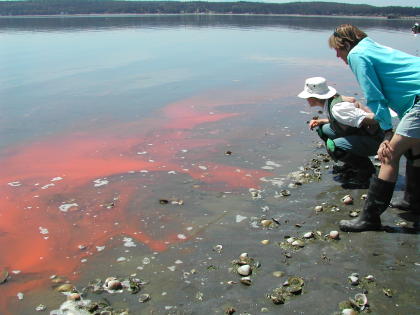
Gulf summit ends with a discussion of harmful algae
By Brandi Dean Caller-Times
March 31, 2006
When red tide bloomed in Corpus Christi last year, no one knew what caused it, how long it would last or how to get rid of it.
Now an expert on the microscopic algae that kills fish, turns water red and wreaks havoc with respiratory systems has added one more item to the list of unknowns: whether it's coming back.
"We don't have any good way of predicting it from year to year," said Tracy Villareal, a research associate professor at the University of Texas Marine Science Institute.
Villareal, who spoke on harmful algal blooms as a panelist at the State of the Gulf of Mexico Summit on Thursday, said that while he believes science is moving in the direction of understanding red tide, it's slow going. The three-day event sponsored by the Texas A&M University-Corpus Christi's Harte Research Institute for Gulf of Mexico Studies, ended Thursday.
"This is a difficult funding area for oceanography at the moment," he said. "We're talking about a very expensive science. The ocean is very large and we're very small."
One thing he could say, however, is that red tide is increasing in the number of blooms. In the past 15 years, Villareal said more blooms have been reported than in the previous 50. Some of it may be attributable to better reporting, but probably not all of it.
"My suspicion is we're not going to see fewer of them," he said.
But that's not the only thing the Gulf Coast has to be aware of, in terms of harmful algae. There's also Ciguatera, which is the most likely of algal blooms to cause problems for people. Villareal said that between 50,000 and 500,000 people are affected by it every year - the span is large because most doctors wouldn't recognize its many and varied symptoms. There have been reports of the algae in Texas, Villareal said, and it also may be getting worse. The algae lives on reefs, so as humans build more artificial reefs - such as those created by oil rigs - it may spread.
Nancy Rabalais, professor at the Louisiana Universities Marine Consortium, added dead zones to the list of Gulf Coast menaces. Dead zones are areas of oceans with little oxygen. Rabalais said they are because of nutrients - particularly nitrogen - that travel down the Mississippi River and into the Gulf. They eventually become food for bacteria that uses up the oxygen, leaving little for fish and shrimp.
Rabalais said one way of decreasing the dead zone is to decrease the use of nitrogen in fertilizer, but she found one other effective method: hurricanes. The storms stir up the water and redistribute oxygen.
"But that's not really the solution I'm advocating," Rabalais said.




No comments:
Post a Comment